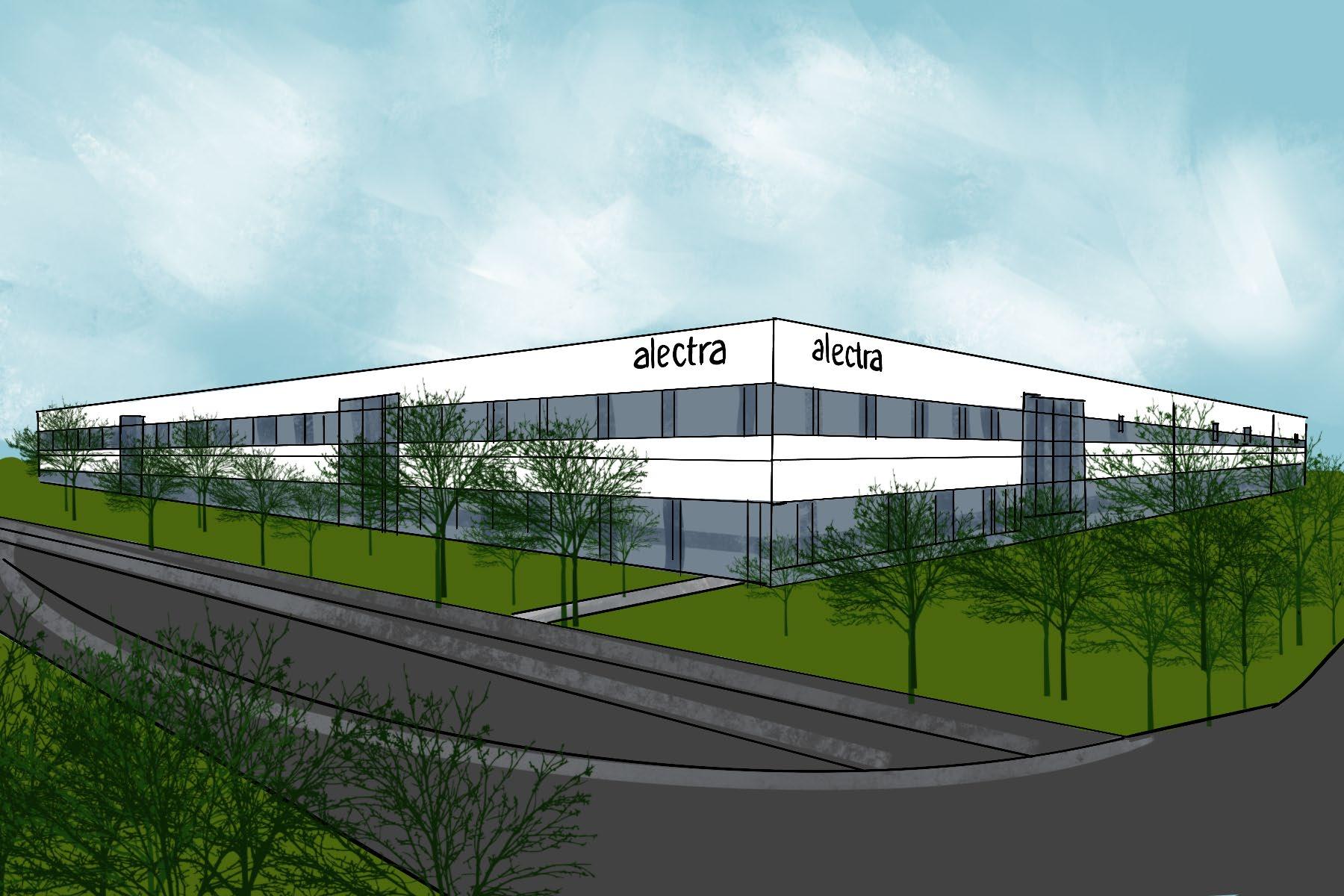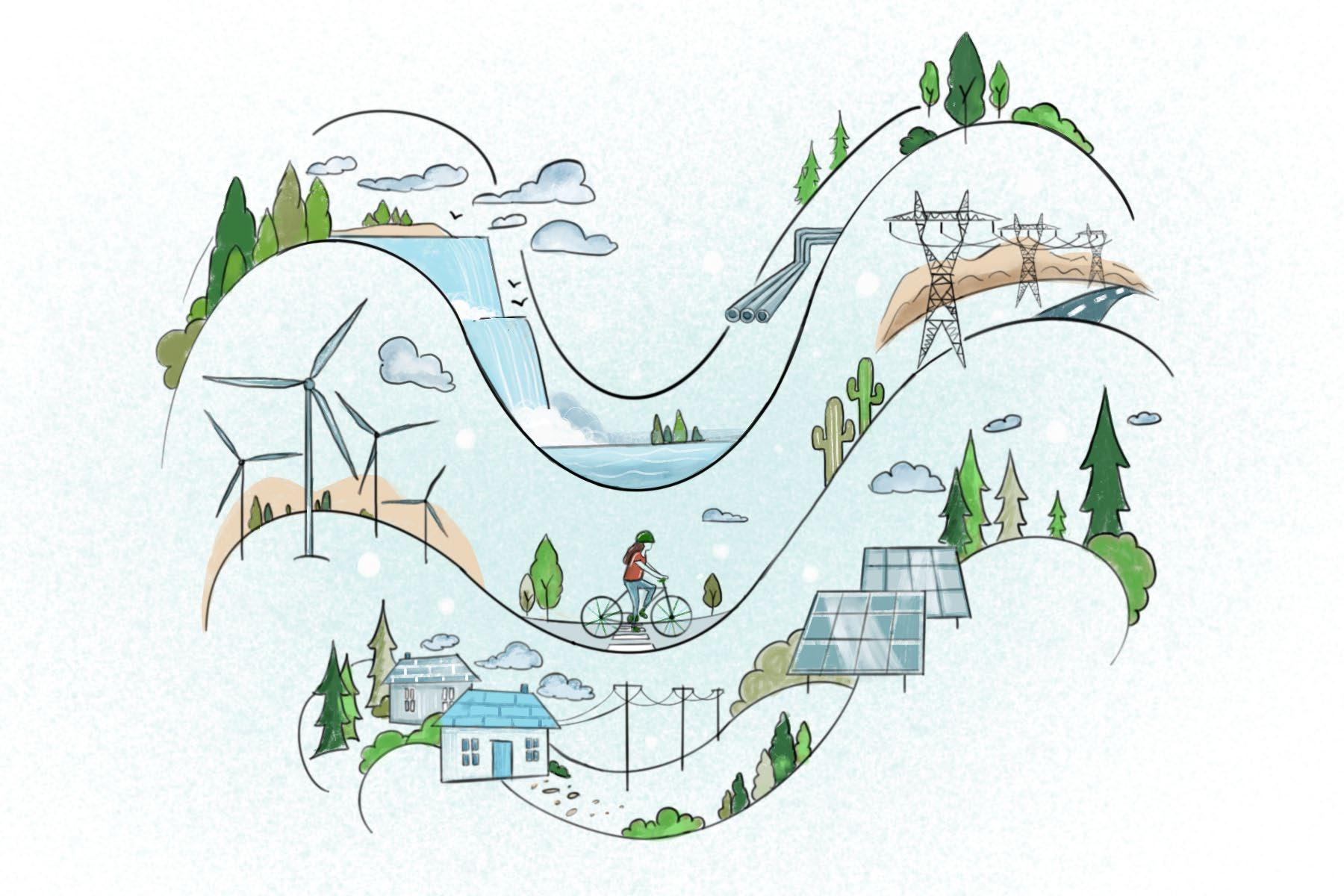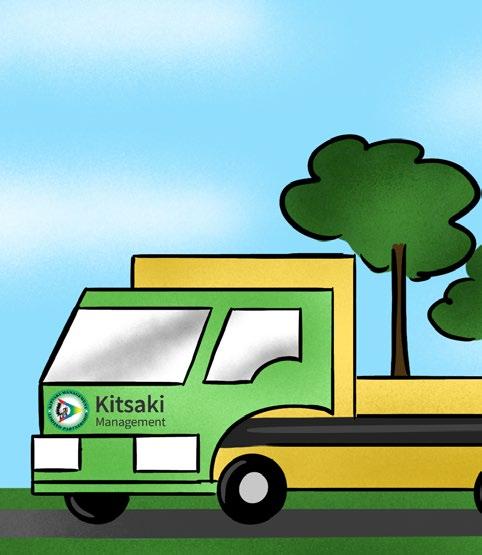
























Stories celebrating community engagement in the electricity sector.
It might be easy to dismiss “sustainability” as a buzzword. The scientific consensus on climate change—and along with it, mainstream awareness—has steadily strengthened as the evidence on warming global temperatures grows.
More and more Canadians are asking for a cleaner, affordable and reliable way to power their day-to-day lives. And increasingly, Canada’s electricity sector has responded by seizing exciting new advances in technology and reporting while working in close collaboration with local communities. This includes the important work of continued relationship-building and reconciliation with Indigenous Peoples to right historical wrongs.
Electricity Canada has been the national voice for sustainable electricity since its founding in 1891. One way we do this is by reporting on the Canadian electricity sector’s sustainability advancements. We highlight best practices, industry trends, and stories.
This year’s publication celebrates the successes of our members. It’s Electricity Canada’s way of telling the Canadian electricity sustainability story.
In this report, you’ll be reading interviews from a wildlife biologist who has a knack for thinking outside the box when it comes to protecting wildlife from power lines. You will also learn more about electricity companies taking a long view when it comes to relationship building and engaging with the Indigenous people in the provinces that they operate in. There is also an interview with an environment and sustainability manager whose children now make use of a community space that was originally created by his employer.
All these, and the other profiles you will read about in this report, are stories about the human side of companies, and how companies think about sustainability and make decisions to improve the environment and the communities in which they are a part.
While Canada’s power grid already generates more than 84 per cent of its electricity from non-emitting sources, there is still room for innovation. In this respect, sustainability is like a ribbon that connects all aspects of a company together. It is an all-encompassing view of how an organization prioritizes the environment, their people and innovation.
We are fortunate to have members who were excited to share their stories and volunteered to be among the first to be a part of this initiative, and we are grateful to everyone profiled for their generosity in talking to us. These stories help to paint this picture of how, together, our members are coming up with creative ways to help our nation meet its 2050 net zero emissions future.
As these stories indicate, sustainability isn’t just a buzzword or a trend, Sustainability is about valuing the environment, people and communities in the work we do in the electricity sector.
Sustainability is for life.
Julia Muggeridge Vice President of Communications and Sustainability, Electricity Canada
In 2023, there were more than 1,000 wildfires reported in Alberta, which burned more than 1.75 million hectares of land and forced the evacuation of thousands of Albertans from their homes. As the frequency and severity of wildfires continue to increase, AltaLink is leading in its effort to reduce the potential that its transmission system contributed to the ignition of a wildfire.
And as wildfires are increasingly a fixture in the news, grappling with its toll – and more importantly, its mitigation – has been part of “AltaLink’s business plans for the last few years says David Huggill, Corporate Sustainability Specialist at AltaLink.
AltaLink was the first utility in Canada to implement a Wildfire Mitigation Plan, and two years later partnered with Electricity Canada to develop and publish a best practices guide for utilities on mitigating wildfire risk and promoting industry resilience.
AltaLink’s Wildfire Mitigation Plan was developed through a sciencebacked approach.
Marie-France Labrie, Business Transformation and Wildfire Program Manager at AltaLink, talks about the experts who were consulted by AltaLink so that the utility could develop insight into fire weather, fire behaviour and modelling.
“AltaLink’s tools help assess the likelihood of ignition spread from our assets and the potential impact to the environment and communities,” she explains. “This information helps us identify mitigation activities. We also learn from past events to ensure our program continues to reduce ignition risk.”
As part of the plan, AltaLink’s actions help protect Albertans from the threat of wildfire caused by its transmission system. In areas that had a high risk of fire, AltaLink worked to rebuild or replace order equipment, increase the frequency of inspections, and update its operational procedures. Following the 2023 wildfires, AltaLink amended its tariff application with the Alberta Utilities Commission to expand its Wildfire Mitigation Plan and expedite its implementation. This plan would accelerate the schedule to resolve deficiencies that could start a fire, and address lines that cause a high proportion of fire ignitions. The expanded plan would also introduce a new dynamic model that allow operators real time awareness of any wildfire.
“Reducing the likelihood that our system contributes to wildfires is a critical part of our job in delivering energy to millions of Albertans,” says Marie-France. “Through our operational practices implemented as part of our plan, strengthening our existing system, and working closely with the communities potentially impacted by wildfire, we can help to keep the system reliable and our customers safe.”
AltaLink’s Wildfire Mitigation Plan demonstrates our commitment to sustainability.
“This really hits the ‘E,’ the ‘S,’ and the ‘G’ in terms of how we respond to things in a coordinated and methodical manner,” David explains. “We are balancing our operations with the risk of wildfire ignition while keeping the safety our employees, contractors and customers as our first priority.”
“Based on that information, we came up with a model that would show us the ignition risks from our assets that looked at what could potentially ignite a fire based on past events and could show us how to prioritize our maintenance work.”


When the power goes out, consumers may be surprised to learn that sometimes it’s because a bird has collided with a power line. Typically, a wing, foot or beak may come in contact with the wires, sending voltage through the bird.
In fact, overhead power lines are the second leading cause of avian deaths in Canada, which has long been a conservation issue.
Keyra Hawley Yurchi, a biologist specializing in wildlife with ATCO Electric, says, “We desperately want to make sure that the habitats and environments that we are building our infrastructure in are safe for the wildlife.”
Keyra, alongside Lance Benoit, the Supervisor of Health, Safety, Security and Environment (HSEE), Innovation and Engagement and a former Operations and Maintenance Team Lead are using innovative technology to find ways to be more effective at everything they do.
ATCO uses drones to place robots onto live distribution lines to apply bird flight diverters at pre-programmed intervals. This work is important to increase the wire’s visibility to birds and ultimately reduce avian collisions. Previously, this work often needed to be done with helicopters, Power Line Technicians, and bucket trucks. Sometimes, it also required a power interruption to customers.
Keyra still recalls the day she asked a contractor why they couldn’t just mark live lines.
“They said, ‘Oh no. Nobody’s doing it.’ And I asked, ‘How come’?”
From that conversation, an idea was born where the various engineering, robotic, aviation and wildlife teams came together to brainstorm and build prototypes in ATCO’s training yard so the team’s trials wouldn’t inconvenience customers. The team did extensive testing for several months on various conductor sizes.
“We tested in areas with farmhouses and with oil and gas customers on it—and we were super successful with it!” Keyra says.
While applying the diverters, cameras on the drone and the robot also allow the team on the ground to inspect and identify damage, fraying and wire cable distortion, like bird caging, which would require immediate removal of the cable from service.
Keyra notes that a bonus of working with robots and drones is that it’s safer. Robots and drones can be used in inclement weather and reduce the need for Power Line Technicians to have to work from a bucket truck or the side of a helicopter.
Keyra and Lance feel fortunate that ATCO is open to their team’s ideas and feels that ATCO stands true to its word regarding being a “good corporate neighbour to the environment.” “ATCO’s dedication is one of the reasons why Lance and I have both been here for an extended amount of time,” Keyra says.
“I am at ATCO because we are empowered to be problem solvers,” Keyra explains. She feels that ATCO stands true to its word regarding being a “good corporate neighbour to the environment.”
“I am at ATCO because we are empowered to be problem solvers,” Keyra explains. She feels that ATCO stands true to its word regarding being a “good corporate neighbour to the environment.”


In many ways, knowing Hydro-Québec is knowing the history of the province itself. Hydroelectricity is one of the key drivers in what makes the province what it is today—and it’s why Hydro-Québec feels a responsibility for identifying, preserving and promoting that shared heritage.
Last year alone, more than 85 000 people visited Hydro-Québec’s 15 sites, where free, guided tours are routinely offered.
One of the ways Hydro-Québec preserves its heritage is by repurposing it.
“We’re in a climate change crisis and you hear it, again and again, that the building that already exists is the greener one,” says Michelle Bélanger, an environmental expert advisor at Hydro-Québec.
In the province, 40% of waste stems from construction alone. That’s why Hydro-Québec has recently changed its heritage building policies to ensure that existing buildings are preserved or repurposed—and by doing this, recover and redeploy heritage buildings by blending the past with the technological advances of the evolving present.
As Michelle puts it: “We’re consciously avoiding waste.”
The utility has a longer-term vision of lowering its environmental impact while taking the historical knowledge passed down from previous generations as key lessons in what works well and what can be improved upon.
Inspired by UNESCO’s idea of “intangible heritage”, Hydro-Québec is ahead of the curve when it comes to the identification, preservation and promotion of its heritage, and the industrial heritage of the province. The utility is working with archeologists and researchers to document the historical “know how” of hydroelectricity workers and experts.
This was all done while continuing to keep the lines of communication open with community partners such as those from Indigenous groups.
There is an embracing of constant innovation at Hydro-Québec with a respectful nod to what has come before. The past is far from being an anchor, but rather a barometer for how far the utility has continued to evolve with the changing tides of time.
“Long before UNESCO promoted the idea of “intangible heritage”— traditions, knowledge, and customs handed down from generation to generation—Hydro-Québec was ahead of the curve. The utility was already working with archeologists and researchers to document the historical “know how” of hydro-electricity workers and experts.”


“We’re continuously trying to upgrade our facilities by looking at ways to reduce greenhouse gas emissions from our buildings,” explains Blair Peberdy Senior Vice-President, Regulatory, Government & Corporate Relations at Alectra.
Reducing Alectra’s carbon footprint was a major consideration when it came to building its new operations centre in Brampton, Ontario, which consolidates two older facilities and brings together more than 400 employees serving Mississauga and Brampton under one roof.
Growing societal awareness of the impacts of climate change has led to an increased focus on adopting sustainable building methods. One of the most widely recognized green building certification programs is the Leadership in Energy and Environmental Design (LEED) certification, which applies a comprehensive approach to evaluating and certifying sustainable building practices.
Alectra’s new state-of-the-art, 215,000 square-foot facility is LEED Gold certified and incorporates upgraded air systems that reduce greenhouse gas emissions by about 43 per cent above LEED standards.
In the 2021 Global Status Report for Buildings and Construction it was noted that reducing carbon output from buildings and construction is vital to limiting global warming given that the construction and operation of buildings accounted for 37% of global energy-related CO 2 emissions in 2020.
James Macumber, VP Supply Chain at Alectra notes that, when they reviewed their older buildings for the greenhouse gases they produced, Alectra’s team also thought about the capital required to upgrade them.
Retrofitting buildings to make them more sustainable is often a complex process that involves several challenges including dealing with dated systems and protocols and interfacing old equipment with modern technologies.
James says that, ultimately, developing a new building was the more sustainable approach by focusing on the benefits of added features such as rooftop solar power generation and providing elective vehicle charging stations for Alectra’s fleet, employees and visitors.
“We installed 500 kilowatts of solar panels on the roof and, by next year, we’ll have more than 25 electric vehicle charging stations,” James says. “The idea is to have solar panels on the carport and reduce our electricity consumption by charging the vehicles with solar panels.”
Alectra was strategic in placing the electric vehicle charging stations on-site.
James explains that Alectra is working towards electrifying its fleet of vehicles as part of its commitment to achieving net-zero emissions by 2050. In September 2023, Alectra added an all-electric double bucket truck to its field operation fleet; the new truck will be used by power line technicians in day-to-day overhead line maintenance operations.
“As our existing fleet starts to age and come out of service and more of these electric service vehicles become available on the market, we’ll see an opportunity to even further reduce our footprint,” James says.
All of the considerations in designing and building the new operation centre speaks to Alectra’s commitment to “walk the talk” when it comes to its commitment to becoming one of the first energy distribution companies in Ontario to becoming a net zero emissions company.
The construction of the Brampton service centre is just one of Alectra’s initiatives aimed at directly targeting greenhouse gas emissions and the energy company promises that there is more to come.
“Ultimately, developing a new building was the more sustainable approach by focusing on the benefits of added features, such as rooftop solar power generation and providing elective vehicle charging stations for Alectra’s fleet, employees and visitors.”


Out and about among the approximately 109,000 solar panels that make up Capital Power’s first Canadian-based solar project, Strathmore Solar, are about 600 groundskeepers—sheep from Whispering Cedars Ranch.
The solar site offers local farmers additional land for their animals to graze. It’s an innovative partnership that helps Capital Power to sustainably reduce fire hazards while keeping its 320-acre facility well-maintained.
Michael Sheehan, Senior Advisor of Indigenous and Stakeholder Engagement, explains it all started when the owners of Whispering Cedars Ranch, which keeps sheep not far from Strathmore Solar first reached out to Capital Power. Both parties were excited about the opportunity.
“Strathmore Solar hosts the sheep on-site to manage grass and maintain weeds,” Michael explains, “The sheep, in turn, have a large, fenced area to protect them from predators, an ample supply of food and they enjoy the shade of the panels.”
While sprawling solar farms have traditionally impacted prime agricultural farmland, Capital Power’s partnership with Whispering Cedars Ranch’s owners has become an opportunity for the firstgeneration farmers to produce food and fibre while also supporting renewable energy.
“The facility is located on 320 acres of industrial-use land leased from the town of Strathmore. The site was ideal because it used to be industrial, but it had close access to transmission and distribution and was in an area with high sun exposure,” Michael says. ”It was land that was otherwise not being used and is immediately adjacent to AltaLink’s Strathmore Substation, so no additional transmission infrastructure was necessary.”
He describes the location as having “high solar energy potential” due to the amount of sunlight it receives. It also has limited environmental impacts to wildlife, native prairie, and wetlands.
The Strathmore Solar facility began commercial operations in March 2022, with photovoltaic panels mounted on a horizontal, single-axis tracking system to automatically change the angle of the panels throughout the day, following the position of the sun as it passes from east to west, helping to produce more solar energy.
Compared to a fixed axis system, the single-axis tracking system increases output by up to 25 per cent because it can follow the sun’s movements and have the bifacial solar panels adjust to the angle at which the sun hits a solar panel, absorbing light from the top and bottom panels, maximizing energy production.
The Strathmore Solar facility, along with Capital Power’s other renewable facilities, support companies to achieve their carbon neutrality goals by contracting 100 per cent renewable energy for their operations and is a prime example of Capital Power’s commitment to the economic development of the local communities in which it operates with the hiring, contracting and sourcing of local supplies.
At the height of the solar facility’s construction, there were more than 146 workers on site.
Michael explains that Capital Power partners with local organizations to grow and sustain communities, which includes supporting initiatives. like the Wheatland County Food Bank Society and the Strathmore High School Community Greenhouse Project.
Michael says, “We value being a part of the communities where we work and live and it’s important to support the organizations and programs that bring our communities to life.”
“While sprawling solar farms have traditionally impacted prime agricultural farmland, Capital Power’s partnership with Whispering Cedar Ranch’s owners has become an opportunity for the first-generation farmers to produce food and fibre while also supporting renewable energy.”


SaskPower counts itself lucky to operate in a province that has a large Indigenous community.
“From a company perspective, we’re very focused on reconciliation— and one of the ways we can do that is through our procurement process,” says Rico Tomsha, Procurement Manager at SaskPower.
SaskPower operations impact many Indigenous communities, so the company wants to ensure they are developing partnerships with Indigenous communities through communication and consultation to ensure a mutually successful and sustainable future.
The utility’s procurement process focuses on involving Saskatchewan’s Indigenous people in economic growth opportunities where goods and services from Indigenous vendors are considered for a variety of projects related to SaskPower’s business.
“We’re trying to focus on partnerships that reflect the demographics of our province and tapping into that workforce through our contractors” explains Rico, as he describes the challenges SaskPower has in its workforce demands.
One such successful partnership is with Amisk, a powerline contractor that is a prequalified vendor under the Distribution Construction Program. They have become a contractor that is consistently awarded competitive procurements. Recently, they have expanded into plowing fibre optic cable in the technology and security space.
Kelly Hewison started Amisk—named after the Cree word for beaver—in the summer of 2019 with the aim of giving Indigenous men and women “an opportunity they might not have otherwise.”
What started out as a company with one truck has grown into a 23-employee operation with 90 per cent of Hewison’s field crew being Indigenous. Amisk is very proud of their Indigenous apprentices that they support and mentor all the way through the process to journeyperson status. They are developing journeyman power line technicians, currently one of the most in demand trades.
Another group SaskPower works with is Kitsaki Vegetation Services, which is experienced in aerial tree trimming, right-of-way brush clearing, danger tree removal, and herbicide application.
“Being a power utility, we need to manage vegetation to prevent fires and to manage the right-of-way for our power lines,” explains Rico. “The majority of our vegetation management in the northern region of the province is completed by Kitsaki, and like Amisk, the partnership has been mutually beneficial.”
Over the past decade, SaskPower has rolled its Indigenous Procurement Policy out at a larger scale.
“We’re interested in renewable energy opportunities and a lot of Indigenous vendors are coming to the plate to support these initiatives. And we see it growing moving forward,” says Rico.
He notes that SaskPower also maintains a requirement that all Independent Power Producers who build and run new renewable power projects in the province have at least 10 per cent Indigenous legal and beneficial ownership so that the company can ensure Indigenous communities have the opportunity for long term revenue streams. The utility plans to implement a new Indigenous community growth and benefits evaluation criteria in 2024.
“We’re trying to find a way to encourage our vendor community— whether they’re Indigenous or not— to work with Indigenous communities, individuals and companies,” Rico says. “This could be anything from bursaries or scholarships to apprenticeship programs, Indigenous employment to developing facilities within the Indigenous community.”
He notes that, strictly from a business perspective, it’s a practice that makes sense. In strengthening ties to Indigenous companies, SaskPower has seen a payoff where labour and capacity shortages exist.
Rico sees it as simple as this: when you talk about sustainability, it’s business relationships such as these that are important in building sustainable business practices.
“We now have strong partnerships with our Indigenous vendors where we can rely on them.” Rico says, “And it’s a very reciprocal relationship where they’ve come through for us in tough situations and prioritized our work.”


A power plant isn’t the first place you’d think of as home to a thriving bee colony, but since June 2023, ENMAX Energy’s Calgary Energy Centre has welcomed tens of thousands of worker bees and two queens into specially prepared hives.
What started off as a fun ENMAX team-building event for the power plant has now turned into a beekeeping operation with two hive boxes just adjacent to the facility.
“This was really an employee initiative,” says Jennifer Saldana, ENMAX’s Director, Environmental, Social and Governance (ESG) Performance and Reporting. “In fact, there were a couple of barriers for them to overcome in order to do it, but they were really passionate about the project.”
This speaks to the corporate culture at ENMAX and how the utility’s ESG principles are upheld by its employees.
“ESG is everyone’s job and is embedded in everything we do,” says Jennifer. “Whether you’re hiring a person and considering diversity of thought or finding ways to reduce emissions in your projects—it’s all ingrained in the way we look at the business with a future-focused outlook.”
The bee colony at the Calgary Energy Centre is just one example. Situated on mostly agricultural land, the power plant serves as a bridge for creating a new ecosystem at an industrial facility.
Rapidly dwindling bee populations over the last few decades have posed a threat to a variety of plants critical to our well-being and livelihoods—especially since one in every three bites of food are courtesy of bees. In fact, some of our favourite summer crops are able to germinate because bees help to transfer pollen.
As pollinators, bees contribute to a complex, interconnected system that allows many different species to co-exist.
Julia Perkins, Senior Communications Strategist at ENMAX says the team was intentional when they chose the location for the bee colony.
“They wanted the hives somewhere they could easily access and that were not too far out of sight, but far enough away from people so the bees wouldn’t get disturbed,” says Julia, noting the hive boxes are easily visible when employees drive onto the site.
With the help of certified beekeeping trainers, this employee-led initiative has encouraged a stronger team dynamic and instilled an appreciation for environmental conservation.
The Calgary Energy Centre’s bee colony is an example of how ENMAX’s projects—both big and small—go beyond the clear environmental benefits and speaks to a commitment to the communities it operates in.
“Rapidly dwindling bee populations over the last few decades have posed a threat to a variety of plants critical to our well-being and livelihoods. With the help of certified beekeeping trainers, this employee-led initiative has encouraged a stronger team dynamic and instilled an appreciation for environmental conservation.”


Even though the Task Force on Climate Related Financial Disclosures (TCFD) was established at the end of 2015 with 11 recommendations, it took a while for organizations to embrace the practice of voluntarily reporting climate-related financial risks and opportunities to investors, lenders, insurers, and other stakeholders.
Fortis Inc., however, was an early adopter.
“We really saw the long-term value that climate scenario analysis would bring to both our utilities and our investors,” says Kealey Martin, Vice President, Sustainability and Climate Strategy at Fortis.
Fortis issued its first TCFD and Climate Assessment report in 2022, with the goal of ensuring that climate-related risks were incorporated into existing risk management, long-term strategy, and financial planning resources. Just recently, Fortis released its 2024 Climate Report, which further details the company’s understanding of climaterelated impacts.
Fortis is made up of 11 utility operations across 18 diverse geographic footprints. “Our geographic reach means climate risks and opportunities look different across our business, says Kealey. “By conducting climate scenario analysis, we could work together in order to consolidate the risks and opportunities for the business. As a group of companies, we saw the benefits of collaboration.”
Her colleague, Jennifer Lawlor, Senior Manager of Sustainability, notes that it can be challenging to know where to begin.
“The advice would be to just start. Try it, and you will learn what it means for your company to see the incremental benefits that come from conducting climate scenario analysis,” says Jennifer. “You don’t have to implement all recommendations right out of the gate. It’s about continually moving the dial to see progress.”
Fortis’ sustainability team understands that climate change is both a risk and an opportunity that our industry will have to manage effectively. Kealey says the frameworks like TCFD can turn into a roadmap for a company’s success in the long run by ensuring good governance on climate risks, opportunities, metrics, and targets.
The key word for developing the climate assessment report is coordination, Kealey notes.
“We were able to leverage the subject-matter expertise across our companies in addition to coordination with external consultants when required,” she explains.
Given their expansive geographic reach, Fortis knew there wouldn’t be a one-size-fits-all scenario.
“We have companies across North America,” Jennifer points out. “So, BC’s climate versus Alberta’s versus Arizona’s and the Caribbean’s means looking at vastly different climate change implications. The people on the ground knew what was happening in terms of the climate there and helped us to walk through the analysis of potential future climate scenarios.”
Climate scenario analysis includes conducting workshops at Fortis utilities—with extra care put into ensuring the right expertise and knowledge-sharing were at the table.
“There was no ‘off-the-shelf scenario’ that we could just pull out and say that’s our scenario,” Kealey explains.
The newest version builds on the strengths of the previous report, including the results of climate scenario analysis using low and high emissions scenarios over three different time horizons (Present day, 2030 and 2050). Physical risks and opportunities were assessed for priority assets utilizing nine climate hazards. Transition risks and opportunities were assessed using a framework based on enterprise risk management principles.
In 2023, the TCFD recommendations were incorporated into the climate-disclosure rules developed by the International Sustainability Standards Board (ISSB), solidifying the importance of TCFD in future climate-related reporting. Going forward, the ISSB will continue the work of TCFD and will monitor progress of the adoption of recommendations.
The exercise has proven to be one that makes smart business sense as it gives Fortis insight into how to include climate considerations alongside customer affordability and system reliability as part of its long-term business strategy.


More than twenty years ago, when FortisBC developed its Statement of Indigenous Principles with guidance and input from several Indigenous leaders across B.C., it cemented the notion that establishing trust and an authentic relationship would be the foundation for future engagement.
Tanya Lain Gahr, Indigenous and Community Relations Manager, says that, at FortisBC, engagement starts years before a pre-feasibility phase of a project happens.
“There needs to be a realistic understanding that the development of a relationship and working towards genuine consent on behalf of a community is going to ensure that we have a more successful project in the end,” says Tanya. “Trying to rush a project is the best way to stop a project.”
This relationship-building was exemplified by the Squamish Nation Environmental Assessment Agreement, which gave the Squamish Nation full and independent environmental oversight on the work being done on their traditional territory.
Tanya explains that this agreement was an example that FortisBC still looks to as one to emulate when engaging with other First Nations.
Reconciliation can take on many forms ranging from partnering on climate action to respecting Indigenous cultures and communities to business development with Indigenous partners.
Tanya notes that advancing equity ownership agreements with Indigenous communities is part of FortisBC’s work towards economic reconciliation. There is an awareness of the history of nation-building that has included putting infrastructure in and on traditional territories without the informed consent of Indigenous people who have been the most impacted as a result.
“For many, many years, there wasn’t any economic benefit going to those communities, so we asked ourselves how can we even begin to right historical wrongs?” Tanya says.
This said, Tanya notes that there have been times where FortisBC has asked First Nations communities what would be a successful outcome of a project and that there are often answers that the company hadn’t anticipated.
One example would be the Pattullo Gas Line Replacement Project, where FortisBC had to consider how it would maintain gas service for its customers once BC’s Transportation Ministry decommissioned the Pattullo Bridge.
The Ministry’s design standards wouldn’t permit a gas line on the new bridge and would, instead, require FortisBC to build six kilometres of new gas line through Burnaby.
Well before construction started, however, FortisBC engaged with stakeholders in the communities where the project would take place. At the request of the Kwikwetlem First Nation, an environmental monitor from their Guardian Environmental Monitoring Program to provide oversight.
This meant overseeing the environment around the Pattullo Project job sites including protecting fish and wildlife and their habitat and culturally sensitive areas by ensuring no harmful materials or sediment entered nearby waterways.
By working together with the communities, Tanya says that “best practices are a minimum—and listening and learning take us well beyond that minimum.”
There have been times where the request from a community has been support for cultural revitalization, which is where FortisBC’s Community Investment Fund comes in.
“There are a number of different things when it comes from the communities. It’s mostly about identifying what is needed. It’s not up to us to determine,” says Tanya. “We’re listening to what communities tell us is something that they see as having value in their cultural sustainability and cultural revitalization efforts.”
She notes that investments have ranged from funding powwows to canoe races to salmon feasts to sweat lodges.
The ongoing work that FortisBC has been doing has been recognized with a silver-level designation in Progressive Aboriginal Relations by the Canadian Council of Aboriginal Business.
The certification is a result of a multi-year process of implementing action plans and targets in business development, leadership actions, employment, and community relationships.
“That was a huge accomplishment for us,” Tanya says. “We were really pleased to get that designation—especially since the normal progression might be to go from ‘committed’ to bronze to silver and then up to gold. To go directly from committed to silver, I think is a testament to our true commitment towards building real relationships.”


With plant and animal species disappearing at alarming rates, the need to preserve biodiversity and use ecosystems sustainably has never been more important.
At Ontario Power Generation (OPG), there’s a strong awareness of the community impacts that its various projects have—including the refurbishment of its Pickering and Darlington sites—and the need to take the time and effort to ensure things are done in a sustainable way.
“It’s a path that we take together with the communities we operate in,” says Barbara Medeiros, Senior Manager, Corporate Environment, Health & Safety.
She explains that OPG’s biodiversity program complements its Climate Change Plan, which aims to have OPG operating as a net zero carbon company by 2040 and help the economies where it operates to achieve net zero by 2050.
Climate change is a major driver of biodiversity erosion, and the loss of biodiversity increases the climate change related risks. Ultimately, there is a responsibility to address these two challenges and the interactions between them.
One of OPG’s biodiversity projects includes a partnership between OPG’s Darlington Nuclear Generating Station and Courtice Secondary School’s woodshop program, where students build and maintain bird boxes that are then dispersed throughout the Darlington and Pickering Nuclear sites.
Certain species of birds need a natural cavity, like a hole in a tree, in order to nest, but the loss of many natural areas and the practice of removing dead standing trees has resulted in fewer available nesting spots.
Bird boxes are a simple and practical way to contribute to wildlife conservation.
“It’s a unique program,” says Carrie-Anne Atkins, Senior Communications Advisor, Stakeholder Relations. In addition to honing their woodworking skills, students also learn about sustainability and the habitat stewardship of the Darlington and Pickering Nuclear sites.
In the spring, OPG has an ornithologist visit the site to tag the birds to get a sense of how many have nested in the boxes. Over the past 25 years, the program has had an average fledgling success rate of 62%, meaning that over the past 25 years, 900+ tree swallows have successfully fledged the nest.
The Wildlife Habitat Council has “gold certified” OPG’s Pickering and Darlington sites in recognition of its commitment to biodiversity and conservation projects.
This gold certification is only awarded to organizations that effectively implement environmental protection to its work and is a designation that OPG is very proud of. The company has maintained this certification for 25 years and it is one of OPG’s many ongoing environmental commitments.
“Certain species of birds need a natural cavity—like a hole in a tree—to nest, but because of the loss of many natural areas, and practices of removing dead standing trees, this has meant fewer available nesting spots. Bird boxes are a simple and practical way to contribute to wildlife conservation.”


Jason Dalton, Environment and Sustainability Manager at Newfoundland Power, attended one of his first EnviroFests over a decade ago.
Newfoundland Power employees helped to build an outdoor learning area at a local school by making several picnic tables so that children could spend time outside of the classroom and take advantage of the beautiful weather in spring just before summer sets in.
“Both of my kids now go to that school and that yard is still there, being utilized,” he says. “It’s funny how things go full circle, and you can see the longevity of a project that came out of a few dollars and a day’s work.”
The annual celebration of the environment encourages positive environmental action. Newfoundland Power has been hosting EnviroFest for over 25 years with funding directed annually to community groups with a “green project” which is then undertaken with the help of employees and community members.
Since EnviroFest’s inception in 1997, Newfoundland Power has partnered with more than 300 community groups, completed over 110 environmental beautification projects, planted more than 3,000 trees and shrubs in communities across the province, from Port aux Basques to St. John’s, and everywhere in between.
“It is completely employee driven,” explains Jason, describing how a community group will come to Newfoundland Power with a proposal and then the employees will assist in bringing an idea to life.
Typically held during Environment Week in June, the idea is to take a community proposal—whether that’s building a greenhouse or a walking trail or developing a pollinator program—and then “go all day long and try to accomplish as much as we can with the tools, equipment, and materials we have to create something that can last a long while and make a meaningful difference to the local community.”
Jason remembers one community asking for help with developing an accessible community garden where those who carry a lot of equipment around on a daily basis—like those who rely on wheelchairs for mobility—have access to garden plots in elevated beds.
Every year, Newfoundland Power is mindful of spreading out the projects all across its service territory and, depending on where the project is happening, employee volunteers can number anywhere from 15 to 30 people.
“We try to hit as many communities as we can and spread out the donations and employee volunteer time as much as possible,” Jason says. “A typical year would have about five community projects from the various proposals.”
Part of EnviroFest is about reducing the province’s environmental footprint and working towards a sustainable future, but another part is about the enthusiasm that Newfoundland Power’s employees have for helping out in the places that they live.
“The community groups really want their help,” Jason explains. “There are a lot of instances where these groups aren’t able to do things on their own and this is a way that we can show that we’re a sustainable electricity leader that wants to be part of the community and that what matters to them matters to us.”
“Part of EnviroFest is about reducing the province’s environmental footprint and working towards a sustainable future, but another part is about the enthusiasm that Newfoundland Power’s employees have for helping out in the places that they live.”












Sustainability for Life is produced by Electricity Canada 1500-275 Slater Street, Ottawa, ON K1P 5H9 electricity.ca
Written by Josephine Li
Illustrations and design by Fatima Khan © 2024 Electricity Canada
